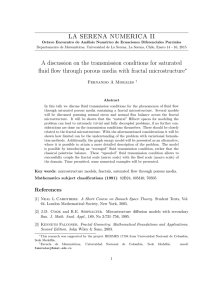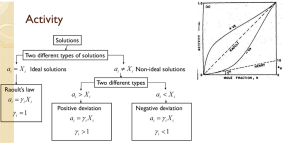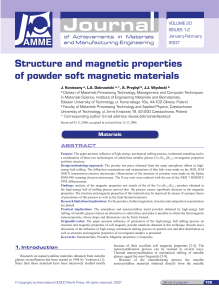Microstructure of a rapidly solidified Al–4V–2Fe ultrahigh strength aluminum alloy
Anuncio
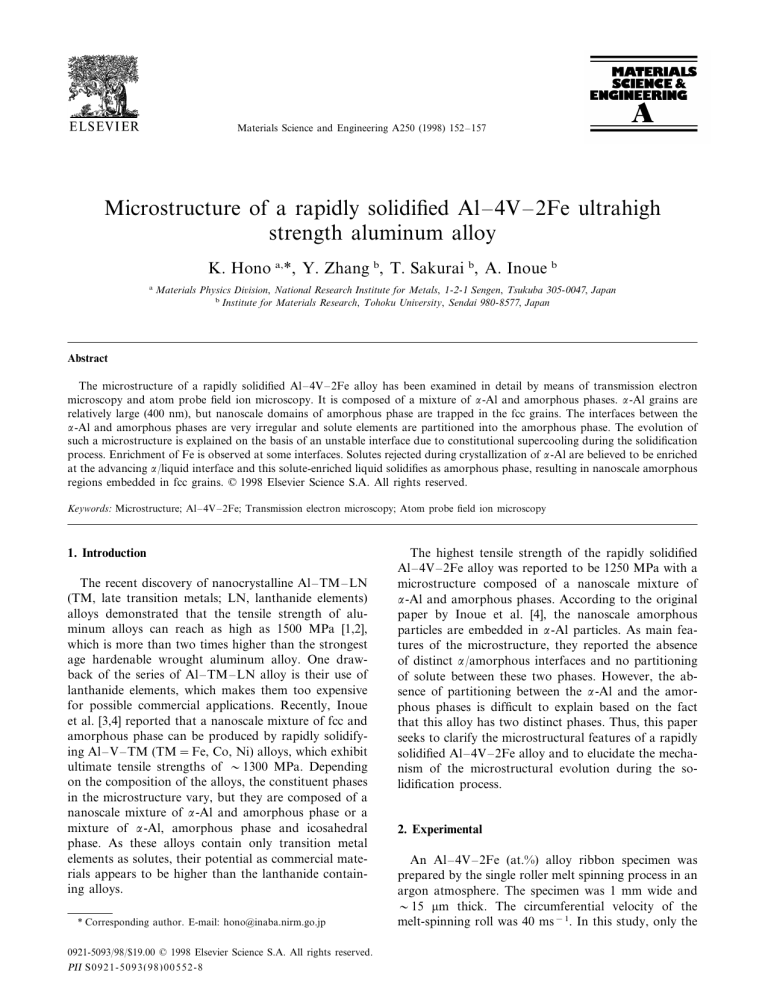
Materials Science and Engineering A250 (1998) 152 – 157 Microstructure of a rapidly solidified Al–4V–2Fe ultrahigh strength aluminum alloy K. Hono a,*, Y. Zhang b, T. Sakurai b, A. Inoue b a Materials Physics Di6ision, National Research Institute for Metals, 1 -2 -1 Sengen, Tsukuba 305 -0047, Japan b Institute for Materials Research, Tohoku Uni6ersity, Sendai 980 -8577, Japan Abstract The microstructure of a rapidly solidified Al–4V – 2Fe alloy has been examined in detail by means of transmission electron microscopy and atom probe field ion microscopy. It is composed of a mixture of a-Al and amorphous phases. a-Al grains are relatively large (400 nm), but nanoscale domains of amorphous phase are trapped in the fcc grains. The interfaces between the a-Al and amorphous phases are very irregular and solute elements are partitioned into the amorphous phase. The evolution of such a microstructure is explained on the basis of an unstable interface due to constitutional supercooling during the solidification process. Enrichment of Fe is observed at some interfaces. Solutes rejected during crystallization of a-Al are believed to be enriched at the advancing a/liquid interface and this solute-enriched liquid solidifies as amorphous phase, resulting in nanoscale amorphous regions embedded in fcc grains. © 1998 Elsevier Science S.A. All rights reserved. Keywords: Microstructure; Al–4V–2Fe; Transmission electron microscopy; Atom probe field ion microscopy 1. Introduction The recent discovery of nanocrystalline Al – TM–LN (TM, late transition metals; LN, lanthanide elements) alloys demonstrated that the tensile strength of aluminum alloys can reach as high as 1500 MPa [1,2], which is more than two times higher than the strongest age hardenable wrought aluminum alloy. One drawback of the series of Al – TM – LN alloy is their use of lanthanide elements, which makes them too expensive for possible commercial applications. Recently, Inoue et al. [3,4] reported that a nanoscale mixture of fcc and amorphous phase can be produced by rapidly solidifying Al–V–TM (TM= Fe, Co, Ni) alloys, which exhibit ultimate tensile strengths of 1300 MPa. Depending on the composition of the alloys, the constituent phases in the microstructure vary, but they are composed of a nanoscale mixture of a-Al and amorphous phase or a mixture of a-Al, amorphous phase and icosahedral phase. As these alloys contain only transition metal elements as solutes, their potential as commercial materials appears to be higher than the lanthanide containing alloys. * Corresponding author. E-mail: [email protected] 0921-5093/98/$19.00 © 1998 Elsevier Science S.A. All rights reserved. PII S0921-5093(98)00552-8 The highest tensile strength of the rapidly solidified Al–4V–2Fe alloy was reported to be 1250 MPa with a microstructure composed of a nanoscale mixture of a-Al and amorphous phases. According to the original paper by Inoue et al. [4], the nanoscale amorphous particles are embedded in a-Al particles. As main features of the microstructure, they reported the absence of distinct a/amorphous interfaces and no partitioning of solute between these two phases. However, the absence of partitioning between the a-Al and the amorphous phases is difficult to explain based on the fact that this alloy has two distinct phases. Thus, this paper seeks to clarify the microstructural features of a rapidly solidified Al–4V–2Fe alloy and to elucidate the mechanism of the microstructural evolution during the solidification process. 2. Experimental An Al–4V–2Fe (at.%) alloy ribbon specimen was prepared by the single roller melt spinning process in an argon atmosphere. The specimen was 1 mm wide and 15 mm thick. The circumferential velocity of the melt-spinning roll was 40 ms − 1. In this study, only the K. Hono et al. / Materials Science and Engineering A250 (1998) 152–157 as-quenched microstructure was examined, since the highest strength was obtained in the as-quenched specimen [4]. TEM specimens were prepared by ion thinning using Fischione Model 3000 ion mill, using 4 kV ion energy and 4 mA ion current. For transmission electron microscopy (TEM), Philips CM200 and JEOL JEM4000EX were employed. For local concentration characterization, an energy compensated time-of-flight atom probe (APFIM) was employed. Needle shaped specimens for APFIM analysis were prepared by electropolishing a square rod of 15 mm ×15 mm × 10 mm which were made by mechanical grinding the ribbon. The atom probe field ion microscope (APFIM) used in the present study was an energy compensated time-of-flight atom probe. The field ion microscopy (FIM) images were observed using Ne as an imaging gas at 25–40 K. The atom probe analysis was performed at 35 K in 1× 10 − 8 Pa vacuum with a pulse fraction (Vp/Vdc) of 0.15 and a pulse repetition rate of 100 Hz. Separation of Al and Fe ions cannot be accurately made by mass analysis, because some of the ions overlap. Most of Al ions are detected as 27Al2 + and 27Al + having mass-to-charge ratio, m/n, at 13.5 and 27, respectively. Fe atoms are detected as doubly charged ions, Fe2 + , having m/n at 27, 28 and 28.5. Thus, 27Fe2 + and 27Al + overlap each other, and it is impossible to separate 153 these. Fortunately, the isotope abundance of 54Fe is 5.8%, thus only 5.8% of Fe atoms will be incorrectly assigned as Al. Al atoms tend to form hydride ions even under an ultrahigh vacuum condition, and a small portion of ions with m/n= 28 is expected to be AlH + which overlap with 56Fe2 + . Thus, the atom probe analysis results presented in this paper is qualitative, rather than quantitative. 3. Results Fig. 1 shows a bright field electron micrograph and the corresponding selected area diffraction pattern (SADP). A crystal grain approximately 30 nm across is observed with dark contrast. The SADP taken from this region suggests that the selected area is composed of almost a single orientation, but with a slightly rotated misorientation with respect to the [001] zone axis. The weak halo ring indicates that an amorphous phase is present within the selected area. Fig. 2 illustrates a bright field image and microdiffraction patterns using a nominal 5 nm converged electron beam taken from the indicated regions. Most of the regions have the same orientation. Some microdiffraction patterns taken from within the grain indicate that amorphous phase remains Fig. 1. Bright field electron micrograph of a rapidly solidified Al – 4V – 2Fe alloy and the selected area diffraction pattern taken from the darkly imaging grain. 154 K. Hono et al. / Materials Science and Engineering A250 (1998) 152–157 Fig. 2. Microdiffraction patterns taken from the darkly imaging grain. Nominal size of 5 nm electron beam was used. within the grain. One microdiffraction pattern shows that the orientation is different from [001], and this indicates that the darkly imaged grain is not a perfect single crystal. The microdiffraction pattern taken from the bright mottled region outside the grain indicates it is largely amorphous, but some crystal reflection with totally different orientation is observed. This means that a crystal which does not satisfy the Bragg condition is mixed with the amorphous phase in this region, and this causes a mottled contrast instead of the featureless contrast typical of amorphous phases. Fig. 3 shows a high resolution image of this specimen taken from the [001] zone of a grain. From the crystallized region, a fringe contrast corresponding to the [001] zone can be observed. The lack of the fringe contrast and the typical isotropic maze-like pattern expected from the amorphous structure indicates the presence of amorphous phase. Some amorphous regions appear to be surrounded by the interconnected a-Al phase. Such an irregular interface suggests that interfacial instability occurs during the growth of the fcc interconnected crystal. Fig. 4 shows an enlarged HREM micrograph obtained from a relatively clear a/amorphous interface. It is interesting to note that the K. Hono et al. / Materials Science and Engineering A250 (1998) 152–157 Fig. 3. HREM image of a rapidly solidified Al–4V–2Fe alloy. Amorphous regions surrounded by interconnected a-Al phase are arrowed. interface is not atomically smooth, but there are atomic protrusions and concavities. This suggests that there is an instability at the interface. A FIM image of the as-quenched Al – 4V – 2Fe alloy is shown in Fig. 5. By selected area atom probe analyses, the brightly imaging regions were confirmed to be the amorphous phase containing higher concentration of solutes. This image clearly shows that the amorphous and fcc phases are entangled with each other. Because the TEM results have shown that the fcc particle with mottled contrast in Fig. 1 is in fact a single crystal containing nanoscale amorphous domains, the fcc phase mixed with the amorphous phase is believed to be interconnected. The darkly imaging regions in the Fig. 4. HREM image of a/amorphous interface in a rapidly solidified Al– 4V – 2Fe alloy. The image is Fourier filtered for clarity. 155 Fig. 5. Ne field ion image of a rapidly-solidified Al – 4V–2Fe alloy. Brightly imaging region corresponds to the solute-rich amorphous phase and the interconnected dimly imaging region corresponds to the a-Al phase. FIM image (Fig. 5) also appear to be interconnected. Solute partitioning in the rapidly quenched Al–4V– 2Fe specimen has been examined by APFIM analysis as shown in Fig. 6. In the concentration depth profiles, the regions which contain mostly Al correspond to the crystallized a-Al. The other regions enriched with V and Fe correspond to the amorphous phase. The concentration of Fe and V in the a-Al phase was determined to be 2 and 3 at.%, respectively. As seen in Fig. 6, it is evident that the solutes partition during the solidification process. The partitioning factors of Fe and V in the amorphous phase with respect to the a-Al are approximately five. In addition to this uniform Fig. 6. Atom probe concentration depth profiles of Al, V and Fe in a rapidly solidified Al – 4V – 2Fe alloy. 156 K. Hono et al. / Materials Science and Engineering A250 (1998) 152–157 Fig. 7. Atom probe concentration depth profiles of Al, V and Fe in a rapidly solidified Al–4V–2Fe alloy. partitioning, we have found another type of solute partitioning as shown in Fig. 7. This concentration profile was obtained from the same batch of material, but from a different region. Again, both V and Fe are rejected from the a-Al phase. In this case, however, the Fe is observed to have separated from the V and is enriched at the interface between the V rich phase and the a-Al phase. The concentration of V in the amorphous phase is : 12 at.%, while that in the a-Al is 2 at.%; thus the partitioning factor of V in the amorphous phase with respect to that in the a-Al phase is approximately six. On the other hand, Fe is enriched at the outer side of the amorphous phase near the amorphous/a interfaces. At both sides of the a/amorphous/a interfaces, Fe is strongly enriched in the amorphous phase near the interfaces. Inside the amorphous, the concentration of Fe is as low as that in the fcc-Al phase. This peculiar concentration profile indicates that there are two types of interfaces in this microstructure. 4. Discussion An earlier paper by Inoue et al. [3] described the features of the melt-spun Al – 4V – 2Fe alloy as follows: (1) homogeneous dispersion of nanoscale amorphous particles in an isolated state; (2) absence of solute partitioning. They also suggested that the amorphous particles precipitate from the supercooled liquid. This study, however, has clearly shown that there is partitioning of solutes between the fcc grains and the dispersed amorphous phase. This suggests that a-Al crystallizes first from the liquid during solidification, and the rejected solute stabilizes the liquid phase result- ing in the formation of amorphous phase in the asquenched microstructure. The presence of amorphous phase in the as-quenched microstructure suggests that there is a deep eutectic in the ternary phase diagram. The primary phase is a-Al, and when the primary particles are nucleated during cooling, rejection of solute occurs from the a-Al. This causes solute enrichment at the advancing interface of the primary aluminum grains. Such solute enrichment at the growing solid/liquid interface can produce constitutional supercooling ahead of the advancing interface, and make growth of a smooth interface unstable provided the temperature gradient in the liquid is not too high. Such constitutional supercooling often causes dendritic growth of crystals, but in the present case, no preferential crystallographic growth has been observed. The inability of a crystallographic dendritic morphology may be explained by the growth direction being primarily determined by the solute mobility rather than the difference in growth rate due to crystal growth anisotropy and thus the growth occurs in more randomly oriented bursts. As the SADP in Fig. 1 indicates, the grains of the primary particles are not perfect single crystals (see mottled contrast in the bright field image in a grain and slight rotation in the SADP), but they contain slight misorientations. This may be explained in terms of slight misorientations developing within different growth fronts similar to misorientations in dendrites. This contrast in the grain is also explained by the existence of nanoscale amorphous regions within the grains. These amorphous regions are believed to be trapped by the growth of the fcc grain. As solute elements are rejected from the a-Al grains during their growth, solute enriched liquid will be entrained in the relatively large a-Al grains. Solute enrichment is believed to stabilize the amorphous phase, and these solute-rich regions will remain amorphous when the specimen is cooled to the room temperature. In addition to these trapped amorphous regions, the matrix amorphous will also remain amorphous as a grain boundary phase. Thus, two types of interfaces may be expected. One is the interface between the entrained amorphous phase and the primary a-Al grains and the other is the interface between the a-Al grains and the matrix amorphous. The concentration of the latter interface will maintain features of the growing interface during the solidification process and such interface will be far from the metastable equilibrium between the amorphous and the primary phase which will be achieved in the former interface. This may explain two types of solute enrichment observed in the APFIM analyses. However, the observation of enrichment of Fe in the amorphous phase near the interface (Fig. 7) is puzzling. From the volume diffusion data in the a-Al, the diffusivity of Fe is expected to be faster K. Hono et al. / Materials Science and Engineering A250 (1998) 152–157 than that of V. Furthermore, the diffusivities of these two elements are expected to be similar. Thus, enrichment of Fe near the interface cannot be explained kinetically. We do not have any good explanation for this observation and further study into the reproducibility of Fe enrichment at the interface is in progress. 5. Conclusion The microstructural feature of a rapidly solidified Al–4V–2Fe alloy has been investigated by TEM and APFIM. The microstructure is composed of relatively large primary crystals of a-Al (40 nm). Nanoscale amorphous particles enriched with Fe and V are present within the primary Al phase by entrainment of the liquid phase during solidification. The interface between the amorphous and the a-Al is irregular, suggesting that interfacial instability occur during solidification due to constitutional supercooling. At some amorphous/a-Al interfaces, enrichment of Fe atoms is observed. . 157 Acknowledgements This study is partly supported by the NEDO International Joint Research Grant on ‘The Nanocrystalline and Supercooled Liquid States of Alloys’. The authors are grateful to Professor W.T. Reynolds at Virginia Tech. and Dr P.J. Warren at University of Oxford for valuable discussions. We also acknowledge Mr Sasamori for preparation of the specimens used in the present study. References [1] Y.-H. Kim, A. Inoue, T. Masumoto, Mater. Trans. JIM 32 (1990) 747. [2] H. Chen, Y. He, G.J. Shiflet, S.J. Poon, Scr. Metall. Mater. 25 (1991) 1421. [3] A. Inoue, H. Kimura, K. Sasamori, T. Masumoto, Mater. Trans. JIM 36 (1995) 1219. [4] A. Inoue, H. Kimura, K. Sasamori, T. Masumoto, Mater. Trans. JIM 37 (1996) 1287.
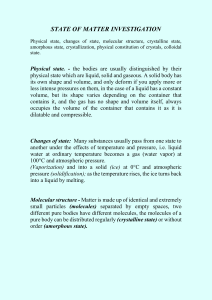
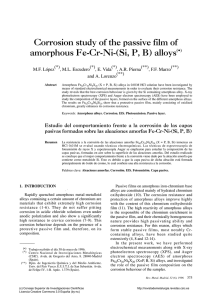
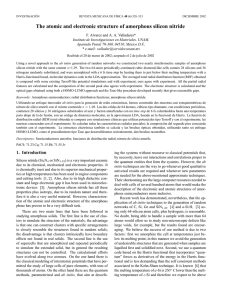
![[ Graphics Card- 710-1-SL]](http://s2.studylib.es/store/data/005308161_1-3d44ecb8407a561d085071135c866b6c-300x300.png)
